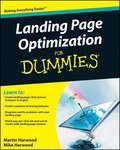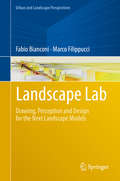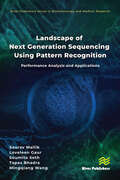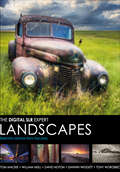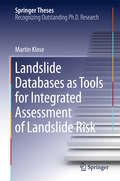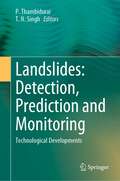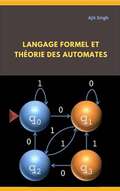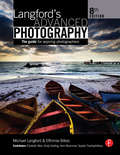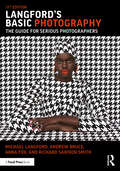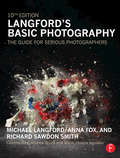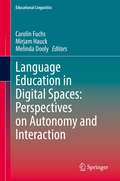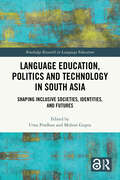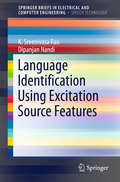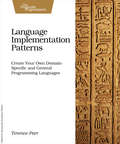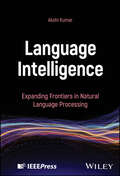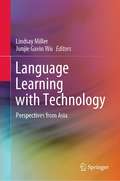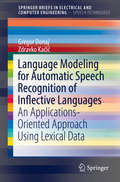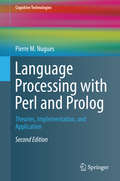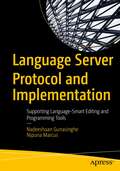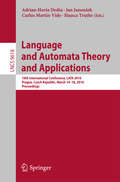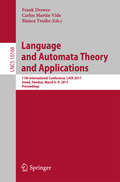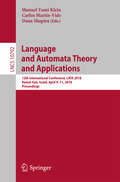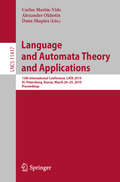- Table View
- List View
Landing Page Optimization For Dummies
by Martin Harwood Mike HarwoodTurn landing pages into profits with the right tools Successful landing pages don't happen by accident, they follow a carefully crafted formula. If you want to convert visitors to your site into sales, it's crucial to understand how to design, monitor, and maintain your landing page. This straightforward, plain-English guide shows you how to cover all the bases-from the visual layout, to using language effectively, to linking strategies, and more. The book is packed with practical tips and techniques, it also identifies common mistakes and pitfalls you should avoid. The book features a valuable $50 coupon off the price of a site diagnosis and webinars on the author's website. Discover the power of language and how to use it as a call to action Start predicting customer browsing behavior Diagnose current problems with your landing page Create a unified marketing message between the search engine result and landing page Examine common optimization approaches Master specific tools for tracking results and follow strict maintenance procedures If you want to make your landing page more appealing, this book provides clear, hands-on explanations and information that you can put to use immediately.
Landscape Lab: Drawing, Perception and Design for the Next Landscape Models (Urban and Landscape Perspectives #20)
by Fabio Bianconi Marco FilippucciThis book explores the relationship between the sciences of representation and the strategy of landscape valorisation. The topic is connected to the theme of the image of the city, which is extended to the territory scale and applied to case studies in Italy’s Umbria region, where the goal is to strike a dynamic balance between cultural heritage and nature. The studies demonstrate how landscape represents an interpretive process of finding meaning, a product of the relationships between mankind and the places in which it lives. The work proceeds from the assumption that it is possible to describe these connections between environment, territory and landscape by applying the Vitruvian triad, composed of Firmitas (solidity), Utilitas (utility) and Venustas(beauty). The environment, the sum of the conditions that influence all life, represents the place’s solidity, because it guarantees its survival. In turn, territory is connected to utility, and through its etymological meaning is linked to possession, to a domain; while landscape, as an “area perceived by people”, expresses the search for beauty in a given place, the process of critically interpreting a vision.
Landscape of Next Generation Sequencing Using Pattern Recognition: Performance Analysis and Applications (River Publishers Series in Biotechnology and Medical Research)
by Loveleen Gaur Mingqiang Wang Saurav Mallik Soumita Seth Tapas BhadraThis book focuses on an eminent technology called next generation sequencing (NGS) which has entirely changed the procedure of examining organisms and will have a great impact on biomedical research and disease diagnosis. Numerous computational challenges have been brought on by the rapid advancement of large-scale next-generation sequencing (NGS) technologies and their application. The term ""biomedical imaging"" refers to the use of a variety of imaging techniques (such as X-rays, CT scans, MRIs, ultrasounds, etc.) to get images of the interior organs of a human being for potential diagnostic, treatment planning, follow-up, and surgical purposes. In these circumstances, deep learning, a new learning method that uses multi-layered artificial neural networks (ANNs) for unsupervised, supervised, and semi-supervised learning, has attracted a lot of interest for applications to NGS and imaging, even when both of these data are used for the same group of patients.The three main research phenomena in biomedical research are disease classification, feature dimension reduction, and heterogeneity. AI approaches are used by clinical researchers to efficiently analyse extremely complicated biomedical datasets (e.g., multi-omic datasets. With the use of NGS data and biomedical imaging of various human organs, researchers may predict diseases using a variety of deep learning models. Unparalleled prospects to improve the work of radiologists, clinicians, and biomedical researchers, speed up disease detection and diagnosis, reduce treatment costs, and improve public health are presented by using deep learning models in disease prediction using NGS and biomedical imaging. This book influences a variety of critical disease data and medical images.
Landscapes: Expert advice from top pros (The Digital SLR Expert)
by David Noton Tom Mackie William Neill Darwin Wiggett Tony WorobiecHEADLINE: Build and Refine Your In-Camera and Photoshop Skills with This Authoritative and Visually Stunning Guide to Capturing Incredible Landscape Photographs Practical demonstrations, step-by-step examples and invaluable secrets from five leading professional photographers show you how to use your digital SLR to its full potential Darwin Wiggett, David Noton, William Neill, Tom Mackie and Tony Worobiec tackle subjects key to taking great landscape images: controlling exposure; understanding light; composing shots; choosing the perfect location and working in black and white Breathtaking photography showcases a wide variety of landscape locations from coasts to mountains, cities to countryside and deserts to forests, highlighting the versatility and full potential of digital photography
Landslide Databases as Tools for Integrated Assessment of Landslide Risk
by Martin KloseThis doctoral thesis presents a novel approach to landslide risk assessment that explores the various dimensions of landslide risk in an integrated perspective. The research approach introduced here is tailored for use with landslide databases and Geographic Information Systems (GIS). A landslide susceptibility model is at the heart of this new approach, enabling to identify and delineate areas at risk of landslides and to assess infrastructure exposure. Landslide risk is a pressing societal issue that is still poorly understood. Temporal landslide hazard is derived from landslide frequency statistics and a hydrological simulation approach to estimate triggering thresholds. These methods are integrated into a powerful toolset for cost modeling that uses historical data to compile, model, and extrapolate damage costs on different spatial scales over time. The combination of this toolset with techniques to analyze fiscal cost impacts supports integrated risk assessment by quantifying the economic relevance of landslide losses.
Landslides: Technological Developments
by T. N. Singh P. ThambiduraiThis book intends to decipher the knowledge in the advancement of understanding, detecting, predicting, and monitoring landslides. The number of massive landslides and the damages they cause has increased across the globe in recent times. It is one of the most devastating natural hazards that cause widespread damage to habitat on a local, regional, and global scale. International experts provide their experience in landslide research and practice to help stakeholders mitigate and predict potential landslides. The book comprises chapters on: Dynamics, mechanisms, and processes of landslides; Geological, geotechnical, hydrological, and geophysical modelling for landslides; Mapping and assessment of hazard, vulnerability, and risk associated with landslides; Monitoring and early warning of landslides; Application of remote sensing and GIS techniques in monitoring and assessment of landslides. The book will be of interest to researchers, practitioners, and decision-makers in adapting suitable modern techniques for landslide study.
Lane-Based Unmanned Aircraft Systems Traffic Management (Unmanned System Technologies)
by Thomas C. Henderson David SacharnyThe age of Advanced Air Mobility (AAM) is upon us, and in ushering new ways to connect and travel, this wave of technology has been compared to GPS and cloud computing. However, new technologies like AAM require tools to build, expand, and understand the capabilities. This book describes an effective and efficient, complete solution to the large-scale, unmanned aircraft systems (UAS) traffic management problem. The authors present a detailed perspective and solutions to some of the major problems involved in coordinating thousands of autonomous vehicles including: virtual highway (lane) creation, strategic deconfliction of flights, dynamic deconfliction, UAS agent behavior learning, anomalous trajectory detection and classification, as well as a set of simulation results for a variety of scenarios (city package delivery, earthquake supply delivery, coalition force coordination through the lane reservation system, etc.).
Langage Formel ET Théorie des Automates
by Ajit SinghLe livre contient une couverture approfondie de tous les sujets liés à la théorie du calcul tels que mentionnés dans les programmes de B.E., M.C.A. et M.Sc. (Informatique) de diverses universités. Une quantité suffisante d'apports théoriques soutenus par un certain nombre d'illustrations sont incluses pour ceux qui s'intéressent profondément au sujet. Dans les premiers chapitres, le livre présente le matériel de base nécessaire à l'étude des théories des automates. Exemples de sujets inclus : langages réguliers et théorème de Kleene ; automates minimaux et monoïdes syntaxiques ; la relation entre les langages sans contexte et les automates à pile ; et les machines de Turing et la décidabilité. Ce livre facilite aux étudiants un style d'écriture plus informel tout en offrant la couverture la plus accessible de la théorie des automates, un traitement solide sur la construction de preuves, de nombreuses figures et diagrammes pour aider à transmettre des idées et des encadrés pour mettre en évidence le matériel connexe. Chaque chapitre offre une abondance d'exercices pour un apprentissage pratique.
Langford's Advanced Photography: The Guide For Aspiring Photographers (Advanced Photography Ser.)
by Michael Langford Efthimia BilissiLangford's Advanced Photography is the only advanced photography guide a serious student or aspiring professional will ever need. In this eighth edition, Efthimia Bilissi continues in the footsteps of Michael Langford by combining an unrivalled level of technical detail with a straightforward writing style while simultaneously bringing the text firmly in to the digital era.This book covers the entire photographic process from a technical standpoint - not only detailing the 'how' but also explaining the 'why' that is so often missing from photography texts. From the workings of cameras, lenses, digital imaging sensors and software to new hot topics such as HDR imaging, digital asset management, and even running your own photography business, everything a serious photographer could need to extend their art into professional realms is covered.The book also benefits from a full glossary, charts and inspirational full color images throughout, with summaries and projects at the end of each chapter to reinforce the theory.
Langford's Basic Photography: The Guide for Serious Photographers
by Michael Langford Andrew Bruce Anna Fox Richard Sawdon SmithThis seminal photography text, now in its 11th edition, has been revamped, reorganized, and modernized to include the most up-to-date and need-to-know information for photographers. Introducing all the key concepts and fundamentals of photography, this book is a must-have for any photographer’s bookcase.Providing examples and practical information throughout to allow photographers to apply concepts to their own work, the text explains the fundamentals of photography in an accessible way. Fully updated to reflect the dynamic changes in the industry, this 11th edition includes expanded and updated content focusing on advances in camera technology and digital lighting, connecting with the global photography industry and professional networks through social media, updated images throughout, and a new chapter on new digital outputs.Ideal as a foundational text for students of photography as well as a key reference for professionals.
Langford's Basic Photography: The Guide for Serious Photographers
by Richard Sawdon Smith Anna FoxThis seminal photography text, now in its 10th edition and celebrating its 50th anniversary, has been revamped, reorganized, and modernized to include the most up-to-date, need to know information for photographers. Ideal for students, beginners, and advanced users wanting to brush up on the fundamentals of photography, this book is a must have for any photographer’s bookcase. The heart of this text, however, retains the same comprehensive mix of scholarly and practical information. The new edition has been fully updated to reflect dynamic changes in the industry. These changes include: an expansion and overhaul of the information on digital cameras and digital printing; an emphasis on updating photographs to include a wider range of international work; replacement of many diagrams with photos; overhaul of the analogue sections to give a more modern tone (ie exposure measurement and film and filters with some more dynamic photo illustrations).
Language Education in Digital Spaces: Perspectives on Autonomy and Interaction (Educational Linguistics #52)
by Carolin Fuchs Mirjam Hauck Melinda DoolyThis book brings together contributions on learner autonomy from a myriad of contexts to advance our understanding of what autonomous language learning looks like with digital tools, and how this understanding is shaped by and can shape different socio-institutional, curricular, and instructional support. To this end, the individual contributions in the book highlight practice-oriented, empirically-based research on technology-mediated learner autonomy and its pedagogical implications. They address how technology can support learner autonomy as process by leveraging the affordances available in social media, virtual exchange, self-access, or learning in the wild (Hutchins, 1995). The rapid evolution and adoption of technology in all aspects of our lives has pushed issues related to learner and teacher autonomy centre stage in the language education landscape. This book tackles emergent challenges from different perspectives and diverse learning ecologies with a focus on social and educational (in)equality. Specifically, to this effect, the chapters consider digital affordances of virtual exchange, gaming, and apps in technology-mediated language learning and teaching ranging from instructed and semi-instructed to self-instructed contexts. The volume foregrounds the concepts of critical digital literacy and social justice in relation to language learner and teacher autonomy and illustrates how this approach may contribute to institutional objectives for equality, diversity and inclusion in higher education around the world and will be useful for researchers and teachers alike.
Language Education, Politics and Technology in South Asia: Shaping Inclusive Societies, Identities, and Futures (Routledge Research in Language Education)
by Uma Pradhan Mohini GuptaBringing together research from the fields of linguistics, education and technology within the dynamic context of South Asia, this timely book investigates the ways in which these fields interact with each other against the backdrop of technological innovation, linguistic diversity and socio-political transformation.Developing and expanding on findings and insights originating from a conference organised by the Education South Asia Initiative at the University of Oxford, this interdisciplinary book features academic reflections on language politics and diversity as well as empirical insights on linguistic, educational and technological transformations in the region. Featuring analytical and methodological approaches to the study of language and education, chapters range in context from India, Bangladesh, Nepal, Pakistan and Sri Lanka, and address a range of issues such as the marginalisation of languages in education and policy, the interactions between language and social hierarchies in the South Asian context, and technology’s impact on language education, acquisition, usage and preservation.Ultimately initiating dialogue on the need for positive changes in language, education research and policy, this book will appeal to scholars, researchers and postgraduate students in the fields of language education, international and comparative education, and education and technology. Policymakers in international development and sociolinguistics may also find the volume of use.The Open Access version of this book, available at http://www.taylorfrancis.com, has been made available under a Creative Commons Attribution-Non Commercial-No Derivatives (CC BY-NC-ND) 4.0 license.
Language Identification Using Excitation Source Features
by K. Sreenivasa Rao Dipanjan NandiThis book discusses the contribution of excitation source information in discriminating language. The authors focus on the excitation source component of speech for enhancement of language identification (LID) performance. Language specific features are extracted using two different modes: (i) Implicit processing of linear prediction (LP) residual and (ii) Explicit parameterization of linear prediction residual. The book discusses how in implicit processing approach, excitation source features are derived from LP residual, Hilbert envelope (magnitude) of LP residual and Phase of LP residual; and in explicit parameterization approach, LP residual signal is processed in spectral domain to extract the relevant language specific features. The authors further extract source features from these modes, which are combined for enhancing the performance of LID systems. The proposed excitation source features are also investigated for LID in background noisy environments. Each chapter of this book provides the motivation for exploring the specific feature for LID task, and subsequently discuss the methods to extract those features and finally suggest appropriate models to capture the language specific knowledge from the proposed features. Finally, the book discuss about various combinations of spectral and source features, and the desired models to enhance the performance of LID systems.
Language Implementation Patterns: Create Your Own Domain-Specific and General Programming Languages
by Terence ParrLearn to build configuration file readers, data readers, model-driven code generators, source-to-source translators, source analyzers, and interpreters. You don't need a background in computer science--ANTLR creator Terence Parr demystifies language implementation by breaking it down into the most common design patterns. Pattern by pattern, you'll learn the key skills you need to implement your own computer languages.Knowing how to create domain-specific languages (DSLs) can give you a huge productivity boost. Instead of writing code in a general-purpose programming language, you can first build a custom language tailored to make you efficient in a particular domain.The key is understanding the common patterns found across language implementations. Language Design Patterns identifies and condenses the most common design patterns, providing sample implementations of each.The pattern implementations use Java, but the patterns themselves are completely general. Some of the implementations use the well-known ANTLR parser generator, so readers will find this book an excellent source of ANTLR examples as well. But this book will benefit anyone interested in implementing languages, regardless of their tool of choice. Other language implementation books focus on compilers, which you rarely need in your daily life. Instead, Language Design Patterns shows you patterns you can use for all kinds of language applications.You'll learn to create configuration file readers, data readers, model-driven code generators, source-to-source translators, source analyzers, and interpreters. Each chapter groups related design patterns and, in each pattern, you'll get hands-on experience by building a complete sample implementation. By the time you finish the book, you'll know how to solve most common language implementation problems.
Language Intelligence: Expanding Frontiers in Natural Language Processing
by Akshi KumarThorough review of foundational concepts and advanced techniques in natural language processing (NLP) and its impact across sectors Supported by examples and case studies throughout, Language Intelligence provides an in-depth exploration of the latest advancements in natural language processing (NLP), offering a unique blend of insight on theoretical foundations, practical applications, and future directions in the field. Comprised of 10 chapters, this book provides a thorough understanding of both foundational concepts and advanced techniques, starting with an overview of the historical development of NLP and essential mechanisms of Natural Language Understanding (NLU) and Natural Language Generation (NLG). It delves into the data landscape crucial for NLP, emphasizing ethical considerations, and equips readers with fundamental text processing techniques. The book also discusses linguistic features central to NLP and explores computational and cognitive approaches that enrich the field’s advancement. Practical applications and advanced processing techniques across various sectors like healthcare, legal, finance, and education are showcased, along with a critical examination of NLP metrics and methods for evaluation. The appendices offer detailed explorations of text representation methods, advanced applications, and Python’s NLP capabilities, aiming to inform, inspire, and ignite a passion for NLP in the ever-expanding digital universe. Written by a highly qualified academic with significant research experience in the field, Language Intelligence covers topics including: Fundamental text processing, covering text cleaning, sentence splitting, tokenization, lemmatization and stemming, stop-word removal, part-of-speech tagging, and parsing and syntactic analysisComputational and cognitive approaches, covering human-like reasoning, transfer learning, and learning with minimal examplesAffective, psychological, and content analysis, covering sentiment analysis, emotion recognition, irony, humour, and sarcasm detection, and indicators of distressMultilingual natural language processing, covering translation and transliteration, cross-lingual models and embeddings, low-resource language processing, and cultural nuance and idiom recognition Language Intelligence is an ideal reference for professionals across sectors and graduate students in related programs of study who have a foundational understanding of computer science, linguistics, and artificial intelligence looking to delve deeper into the intricacies of NLP.
Language Learning with Technology: Perspectives from Asia
by Lindsay Miller Junjie Gavin WuThis book is about language learning with technology, offering readers theoretical insights as well as practical case studies with a focus on Asia and Asian students. Although technology is rapidly advancing and most, if not all, students are already using technology in their everyday lives, traditional teaching/learning practices still exist throughout Asia. This book provides examples, written by representative educators, from a variety of countries/regions and contexts where technology has successfully been used to enhance language learning. In addition to some everyday examples of using technology: Wikipedia, PowerPoint, Google Docs and YouTube, the book also offers the readers an insight into the future possible uses of advanced technology: Augmented Reality, Virtual Reality, Artificial Intelligence and Eye Tracking. The book presents illustrations of how teachers can, and perhaps should, be open to integrating some form of technology into in-class learning or using it to supplement out-of-class activities.
Language Machines: Cultural AI and the End of Remainder Humanism (Posthumanities #74)
by Leif WeatherbyHow generative AI systems capture a core function of language Looking at the emergence of generative AI, Language Machines presents a new theory of meaning in language and computation, arguing that humanistic scholarship misconstrues how large language models (LLMs) function. Seeing LLMs as a convergence of computation and language, Leif Weatherby contends that AI does not simulate cognition, as widely believed, but rather creates culture. This evolution in language, he finds, is one that we are ill-prepared to evaluate, as what he terms &“remainder humanism&” counterproductively divides the human from the machine without drawing on established theories of representation that include both. To determine the consequences of using AI for language generation, Weatherby reads linguistic theory in conjunction with the algorithmic architecture of LLMs. He finds that generative AI captures the ways in which language is at first complex, cultural, and poetic, and only later referential, functional, and cognitive. This process is the semiotic hinge on which an emergent AI culture depends. Weatherby calls for a &“general poetics&” of computational cultural forms under the formal conditions of the algorithmic reproducibility of language. Locating the output of LLMs on a spectrum from poetry to ideology, Language Machines concludes that literary theory must be the backbone of a new rhetorical training for our linguistic-computational culture.
Language Modeling for Automatic Speech Recognition of Inflective Languages
by Gregor Donaj Zdravko KačičThis book covers language modeling and automatic speech recognition for inflective languages (e. g. Slavic languages), which represent roughly half of the languages spoken in Europe. These languages do not perform as well as English in speech recognition systems and it is therefore harder to develop an application with sufficient quality for the end user. The authors describe the most important language features for the development of a speech recognition system. This is then presented through the analysis of errors in the system and the development of language models and their inclusion in speech recognition systems, which specifically address the errors that are relevant for targeted applications. The error analysis is done with regard to morphological characteristics of the word in the recognized sentences. The book is oriented towards speech recognition with large vocabularies and continuous and even spontaneous speech. Today such applications work with a rather small number of languages compared to the number of spoken languages.
Language Processing with Perl and Prolog
by Pierre M. NuguesThe areas of natural language processing and computational linguistics have continued to grow in recent years, driven by the demand to automatically process text and spoken data. With the processing power and techniques now available, research is scaling up from lab prototypes to real-world, proven applications. This book teaches the principles of natural language processing, first covering practical linguistics issues such as encoding and annotation schemes, defining words, tokens and parts of speech and morphology, as well as key concepts in machine learning, such as entropy, regression and classification, which are used throughout the book. It then details the language-processing functions involved, including part-of-speech tagging using rules and stochastic techniques, using Prolog to write phase-structure grammars, syntactic formalisms and parsing techniques, semantics, predicate logic and lexical semantics and analysis of discourse and applications in dialogue systems. A key feature of the book is the author's hands-on approach throughout, with sample code in Prolog and Perl, extensive exercises, and a detailed introduction to Prolog. The reader is supported with a companion website that contains teaching slides, programs and additional material. The second edition is a complete revision of the techniques exposed in the book to reflect advances in the field the author redesigned or updated all the chapters, added two new ones and considerably expanded the sections on machine-learning techniques.
Language Server Protocol and Implementation: Supporting Language-Smart Editing and Programming Tools
by Nadeeshaan Gunasinghe Nipuna MarcusUnderstand the important aspects of implementing a production-grade language server in support of language-smart tools such as code editors and other programming utilities. This book shows you how to create a single implementation of a language server that can be used by multiple tools, enabling you to do the job once in a way that can be shared and reused. This book covers the language server protocol used for communication between programming tools and your language server. The book also provides an in-depth understanding of the design, implementation, and user experience aspects which should be considered when implementing a language server. The book walks you through an example language server implementation to illustrate the basic concepts, then goes on to cover advanced aspects of language server use such as progress reporting, launchers, and extension points. User experience is an important aspect of language server implementation and different tooling vendors strive to provide their own unique user experiences. This book explains how the protocol features can be leveraged to address the unique developer experience provided by different tooling vendors. The book also shows how to enhance the smoothness of the editing experience by orchestrating multiple features together.What You Will LearnImplement a language server from scratchUnderstand language server protocol and its data modelsLeverage the protocol while preserving the unique user experience of different editorsExtend the protocol to support more than its standard capabilitiesRun a language server on top of launchers such as standard I/O and TCP socketSeamlessly incorporate language semantics into your protocol featuresWho This Book Is ForDevelopers focused on and passionate about implementing language development tools such as plug-ins and extensions for interactive development environments (IDEs) or other tools that rely upon parsing of language statements and commands, and developers who need an in-depth understanding of the language server protocol as well as how to use the language server protocol to develop extensible language services
Language and Automata Theory and Applications
by Carlos Martín-Vide Adrian-Horia Dediu Jan Janoušek Bianca TrutheThis book constitutes the refereed proceedings of the 10th InternationalConference on Language and Automata Theory and Applications, LATA 2016, held inPrague, Czech Republic, in March 2016. The 42 revised full papers presented together with 5 invited talks werecarefully reviewed and selected from 119 submissions. The papers cover thefollowing topics: algebraic language theory; algorithms for semi-structureddata mining, algorithms on automata and words; automata and logic; automata forsystem analysis and program verification; automata networks, concurrency andPetri nets; automatic structures; cellular automata, codes, combinatorics onwords; computational complexity; data and image compression; descriptionalcomplexity; digital libraries and document engineering; foundations of finitestate technology; foundations of XML; fuzzy and rough languages; grammaticalinference and algorithmic learning; graphs and graph transformation; languagevarieties and semigroups; parallel and regulated rewriting; parsing; patterns;string and combinatorial issues in computational biology and bioinformatics;string processing algorithms; symbolic dynamics; term rewriting; transducers;trees, tree languages and tree automata; weighted automata.
Language and Automata Theory and Applications
by Carlos Martín-Vide Frank Drewes Bianca TrutheThis book constitutes the refereed proceedings of the 9th International Conference on Language and Automata Theory and Applications, LATA 2015, held in Nice, France in March 2015. The 53 revised full papers presented together with 5 invited talks were carefully reviewed and selected from 115 submissions. The papers cover the following topics: algebraic language theory; algorithms for semi-structured data mining, algorithms on automata and words; automata and logic; automata for system analysis and program verification; automata networks, concurrency and Petri nets; automatic structures; cellular automata, codes, combinatorics on words; computational complexity; data and image compression; descriptional complexity; digital libraries and document engineering; foundations of finite state technology; foundations of XML; fuzzy and rough languages; grammatical inference and algorithmic learning; graphs and graph transformation; language varieties and semigroups; parallel and regulated rewriting; parsing; patterns; string and combinatorial issues in computational biology and bioinformatics; string processing algorithms; symbolic dynamics; term rewriting; transducers; trees, tree languages and tree automata; weighted automata.
Language and Automata Theory and Applications: 12th International Conference, Lata 2018, Ramat Gan, Israel, April 9-11, 2018, Proceedings (Lecture Notes in Computer Science #10792)
by Shmuel Tomi Klein Carlos Martín-Vide Dana ShapiraThis book constitutes the refereed proceedings of the 12th International Conference on Language and Automata Theory and Applications, LATA 2018, held in Ramat Gan, Israel, in April 2018.The 20 revised full papers presented together with 3 invited papers were carefully reviewed and selected from 58 submissions. The papers cover fields like algebraic language theory, algorithms for semi-structured data mining, algorithms on automata and words, automata and logic, automata for system analysis and programme verification, automata networks, automatic structures, codes, combinatorics on words, computational complexity, concurrency and Petri nets, data and image compression, descriptional complexity, foundations of finite state technology, foundations of XML, grammars (Chomsky hierarchy, contextual, unification, categorial, etc.), grammatical inference and algorithmic learning, graphs and graph transformation, language varieties and semigroups, language-based cryptography, mathematical and logical foundations of programming methodologies, parallel and regulated rewriting, parsing, patterns, power series, string processing algorithms, symbolic dynamics, term rewriting, transducers, trees, tree languages and tree automata, and weighted automata.
Language and Automata Theory and Applications: 13th International Conference, LATA 2019, St. Petersburg, Russia, March 26-29, 2019, Proceedings (Lecture Notes in Computer Science #11417)
by Carlos Martín-Vide Alexander Okhotin Dana ShapiraThis book constitutes the refereed proceedings of the 13th International Conference on Language and Automata Theory and Applications, LATA 2019, held in St. Petersburg, Russia, in March 2019. The 31 revised full papers presented together with 5 invited talks were carefully reviewed and selected from 98 submissions. The papers cover the following topics: Automata; Complexity; Grammars; Languages; Graphs, trees and rewriting; and Words and codes.
